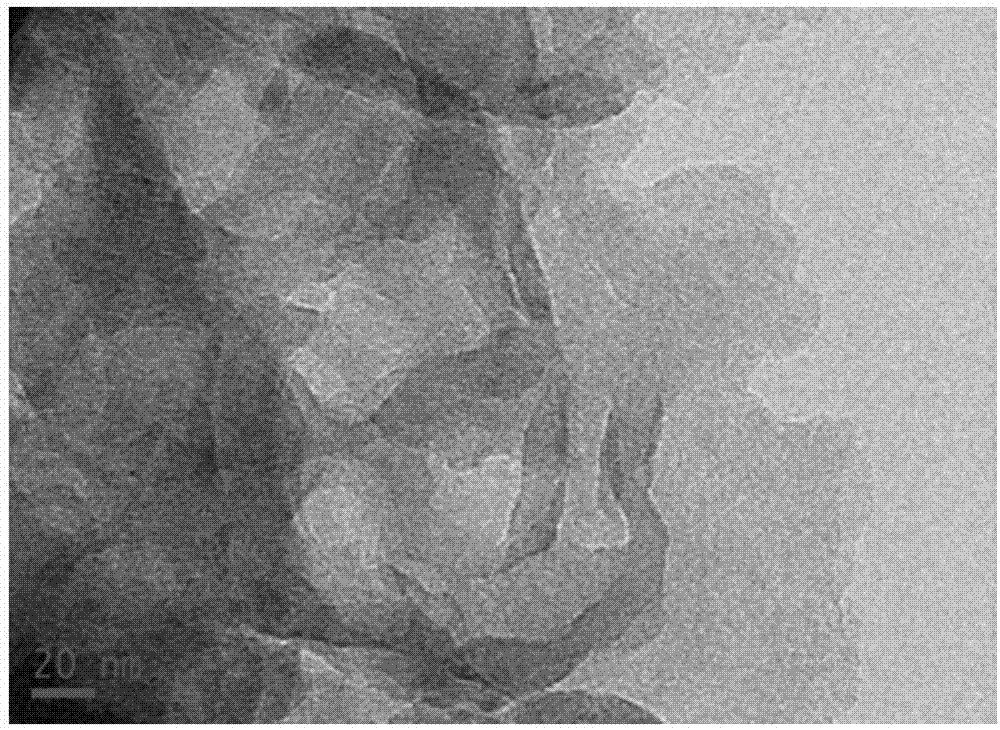Electrochemical sensor for detecting mercury as well as preparation method and application of electrochemical sensor
An electrochemical and sensor technology, applied in the field of genes, can solve problems such as unstable fixation, affecting DNA activity, and easy use of environmentally harmful substances, so as to achieve the effects of improving efficiency and sensitivity, making it easy to manufacture, and maintaining biological activity
- Summary
- Abstract
- Description
- Claims
- Application Information
AI Technical Summary
Problems solved by technology
Method used
Image
Examples
Embodiment 1
[0047] A kind of electrochemical sensor for detecting mercury of the present invention, see figure 1 : Including a glassy carbon electrode used as a working electrode in a three-electrode system, the surface of the detection end of the glassy carbon electrode is modified with carbon-doped graphene-like carbon nitride, and the carbon-doped graphene-like carbon nitride is deposited with Nano gold particles. Since there are available adsorption sites on the gold nanoparticles, add thiol-modified probe P1 on the glassy carbon electrode. site. Then add probe P2, part of the deoxyribonucleotide of probe P2 can form a double-stranded structure with the part of the deoxyribonucleotide of the probe P1 modified by the sulfhydryl group through thymine-mercury-thymine complementary pairing, and the probe P1 and The other part of the unpaired deoxyribonucleotides in the probe P2 are respectively paired with another thiol-modified probe P3 immobilized on the gold nanoparticles through bas...
Embodiment 2
[0057] A preparation method of the electrochemical sensor of embodiment 1, specifically comprises the following steps:
[0058] (1) Preparation of carbon-doped graphene-like carbon nitride:
[0059] Put 1 g of melamine in a reaction kettle with a volume of 100 mL, inject 80 mL of absolute ethanol, and react at a temperature of 200° C. for 24 h to obtain a colorless and transparent product. After drying the colorless and transparent product at room temperature, wrap it with tin foil, transfer it to a muffle furnace, raise the temperature to 520°C at a rate of 2°C / min, and calcinate at 520°C for 4h to obtain a carbon-doped graphene-like phase carbon nitride.
[0060] (2) Glassy carbon electrode pretreatment:
[0061] Polish the surface of the glassy carbon electrode (GCE), then rinse the surface of the glassy carbon electrode with water, then ultrasonically clean it with nitric acid, acetone, and ultrapure water, and finally use Tris-HCl buffer solution (Tris -HCl buffer solu...
Embodiment 3
[0074] A kind of application of the electrochemical sensor of embodiment 1 in detecting mercury ion, concrete detection method is:
[0075] (1) Probe P2 is respectively mixed with mercury ions of gradient concentration (mercury ion concentration is 10 -7 M, 5.0×10 -8 M, 1.0×10 -8 M, 5.0×10 -9 M, 1.0×10 -9 M, 5.0×10 -10 M, 1.0×10 -10 M, 5.0×10 -11 M, 2.0×10 -11 M, 1.0×10 -11 M) Mix well, the concentration of probe P2 is 1 μM.
[0076] (2) Probe P1 / nano-gold / carbon doped graphene-like phase carbon nitride modified glassy carbon electrode is soaked in the mixed solution of mercury and probe P2, so that probe P1, mercury and probe P2 react at room temperature for 30min .
[0077](3) The glassy carbon electrode obtained in step (2) was reacted with P3 immobilized on the surface of gold nanoparticles at 37°C for 60 minutes (reaction time can be 30-90 minutes), and the concentration of probe P3 was 2 μM.
[0078] (4) Soak the glassy carbon electrode of the assembled electr...
PUM
 Login to View More
Login to View More Abstract
Description
Claims
Application Information
 Login to View More
Login to View More - R&D
- Intellectual Property
- Life Sciences
- Materials
- Tech Scout
- Unparalleled Data Quality
- Higher Quality Content
- 60% Fewer Hallucinations
Browse by: Latest US Patents, China's latest patents, Technical Efficacy Thesaurus, Application Domain, Technology Topic, Popular Technical Reports.
© 2025 PatSnap. All rights reserved.Legal|Privacy policy|Modern Slavery Act Transparency Statement|Sitemap|About US| Contact US: help@patsnap.com



